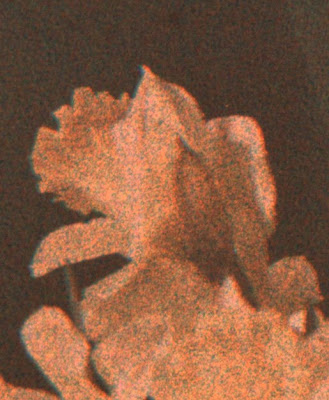
In a previous post I have explored the early colour methods using RGB filters to make colour images.
In this post we'll be looking at the first commercially viable colour process- Autochrome.
Autochrome was the first generally available process for colour photography and was invented by the brothers Auguste and Louis Lumiere and was first commercially marketed in 1907.
The plates were made by mixing potato starch grains which were dyed three colours red/orange, green and blue violet. These were then coated onto a glass plate with the gaps filled by 'lamp black' a type of graphite, they were then sealed with a varnish after which a orthochromatic monochrome emulsion was added.

The image is actually quite dense, when originally shot a slide like the one above shot indoors may have taken several miniutes to expose, even outdoor shots in sunlight may have taken a few seconds.
The colours are wonderful though, to think this slide is one hundred years old this technology must have been fantastic at the time.

Above is a close-up view of the grain structure which has been described by some as pointillist, but I quite like it- Autochomes certainly have a unique look!
The slide in this post was bought on ebay for a few pounds and is a lovely slice of photographic history. The original may have shifted slightly in colour or the orange-red look may have been characteristic of the slide at the time of development.
I have attempted to 'correct' the following image using the wonders of modern technology, not sure if I like it any better...

One thing is for sure Autochrome was a wonderful process.


2 comments:
Hi Mark,
Last month I bought a book with the photographs by Frank Hurley of Shackleton's famous Antarctica expedition 1914-1917. Hundreds of pictures, most of them b&w, but some in colour too. Hurley was one of the first photographers (I think he was the first) to picture Antarctica in colour. He used for that a "Paget Colour" outfit, which consists of glass plates coated according to the same autochrome process that you describe.
Hurley and the other men went through great lengths to preserve the plates throughout the gruesome expedition. Eventually 32 colour plates survived (in total he took nearly 500 photographs).
The book contains 17 of these colour pictures. Like with your flowers the colours are off in all of them, although they may have been better in Hurley's days. But it doesn't really matter because it is simply fantastic to look at colour pictures from almost a century ago. I think Hurley did a terrific job in all sorts of ways (as did the other crew members).
I can heartily recommend this book to you or anybody else interested in 'old pictures', autochrome as well as b&w. The book also contains detailed information about the equipment Hurley used. ("South with Endurance, Shackleton's Antarctic Expedition 1914-1917, The photographs of Frank Hurley", Bloomsbury 2001.)
Thanks for the article Mark. I had not seen a picture of a real autochrome plate before. I think you made a great buy for your few pounds!
Sander.
Sander
My Step father has the book, Hurley is a photographic hero of mine, that famous shot of Shackletons ship covered in ice was a long exposure with many powder flashes to give dramatic lighting.
This is another book of early colour
http://www.albertkahn.co.uk/
You'll have to cut and paste as links don't always work in this reply format.
Thanks for your comments
Mark
Post a Comment